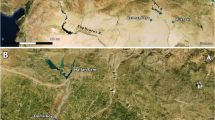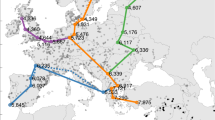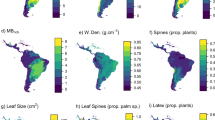Abstract
The onset of plant cultivation is one of the most important cultural transitions in human history1,2,3,4. Southwestern Amazonia has previously been proposed as an early centre of plant domestication, on the basis of molecular markers that show genetic similarities between domesticated plants and wild relatives4,5,6. However, the nature of the early human occupation of southwestern Amazonia, and the history of plant cultivation in this region, are poorly understood. Here we document the cultivation of squash (Cucurbita sp.) at about 10,250 calibrated years before present (cal. yr bp), manioc (Manihot sp.) at about 10,350 cal. yr bp and maize (Zea mays) at about 6,850 cal. yr bp, in the Llanos de Moxos (Bolivia). We show that, starting at around 10,850 cal. yr bp, inhabitants of this region began to create a landscape that ultimately comprised approximately 4,700 artificial forest islands within a treeless, seasonally flooded savannah. Our results confirm that the Llanos de Moxos is a hotspot for early plant cultivation and demonstrate that—ever since their arrival in Amazonia—humans have markedly altered the landscape, with lasting repercussions for habitat heterogeneity and species conservation.
This is a preview of subscription content, access via your institution
Access options
Access Nature and 54 other Nature Portfolio journals
Get Nature+, our best-value online-access subscription
$29.99 / 30 days
cancel any time
Subscribe to this journal
Receive 51 print issues and online access
$199.00 per year
only $3.90 per issue
Buy this article
- Purchase on Springer Link
- Instant access to full article PDF
Prices may be subject to local taxes which are calculated during checkout



Similar content being viewed by others
Code availability
Code used for the calibration of the 14C dates in OxCal is available in the Supplementary Information.
References
Larson, G. et al. Current perspectives and the future of domestication studies. Proc. Natl Acad. Sci. USA 111, 6139–6146 (2014).
Zohary, D. & Hopf, M. Domestication of Plants in the Old World: the Origin and Spread of Cultivated Plants in West Asia, Europe and the Nile Valley (Oxford Univ. Press, 2000).
Zeder, M. A., Bradley, D. G., Smith, B. D. & Emshwiller, E. Documenting Domestication: New Genetic and Archaeological Paradigms (Univ. California Press, 2006).
Piperno, D. R. & Pearsall, D. M. The Origins of Agriculture in the Lowland Neotropics (Academic, 1998).
Piperno, D. R. The origins of plant cultivation and domestication in the New World tropics: patterns, process, and new developments. Curr. Anthropol. 52, S453–S470 (2011).
Clement, C. R., de Cristo-Araújo, M., d’Eeckenbrugge, G. C., Alves Pereira, A. & Picanço-Rodrigues, D. Origin and domestication of native Amazonian crops. Diversity (Basel) 2, 72–106 (2010).
Olsen, K. & Schaal, B. Microsatellite variation in cassava (Manihot esculenta, Euphorbiaceae) and its wild relatives: further evidence for a southern Amazonian origin of domestication. Am. J. Bot. 88, 131–142 (2001).
Sanjur, O. I., Piperno, D. R., Andres, T. C. & Wessel-Beaver, L. Phylogenetic relationships among domesticated and wild species of Cucurbita (Cucurbitaceae) inferred from a mitochondrial gene: implications for crop plant evolution and areas of origin. Proc. Natl Acad. Sci. USA 99, 535–540 (2002).
Clement, C. R. et al. The domestication of Amazonia before European conquest. Proc. R. Soc. Lond. B 282, 20150813 (2015).
Scaldaferro, M. A., Barboza, G. E. & Acosta, M. C. Evolutionary history of the chili pepper Capsicum baccatum L. (Solanaceae): domestication in South America and natural diversification in the seasonally dry tropical forests. Biol. J. Linn. Soc. 124, 466–478 (2018).
Watling, J. et al. Direct archaeological evidence for Southwestern Amazonia as an early plant domestication and food production centre. PLoS ONE 13, e0199868 (2018).
Lombardo, U. et al. Early and middle Holocene hunter-gatherer occupations in western Amazonia: the hidden shell middens. PLoS ONE 8, e72746 (2013).
Capriles, J. M. et al. Persistent Early to Middle Holocene tropical foraging in southwestern Amazonia. Sci. Adv. 5, eaav5449 (2019).
Hilbert, L. et al. Evidence for mid-Holocene rice domestication in the Americas. Nat. Ecol. Evol. 1, 1693–1698 (2017).
Lombardo, U. et al. Holocene land cover change in south-western Amazonia inferred from paleoflood archives. Global Planet. Change 174, 105–114 (2019).
Chandler-Ezell, K., Pearsall, D. M. & Zeidler, J. A. Root and tuber phytoliths and starch grains document manioc (Manihot esculenta) arrowroot (Maranta arundinacea) and llerén (Calathea sp.) at the Real Alto site, Ecuador. Econ. Bot. 60, 103–120 (2006).
Piperno, D. R. Phytoliths (AltaMira Press, 2006).
Morcote-Ríos, G., Bernal, R. & Raz, L. Phytoliths as a tool for archaeobotanical, palaeobotanical and palaeoecological studies in Amazonian palms. Bot. J. Linn. Soc. 182, 348–360 (2016).
Hanelt, P., Buttner, R. & Mansfeld, R. Mansfeld’s Encyclopedia of Agricultural and Horticultural Crops (except Ornamentals) (Springer, 2001).
Smith, B. D. The initial domestication of Cucurbita pepo in the Americas 10,000 years ago. Science 276, 932–934 (1997).
Piperno, D. R. & Stothert, K. E. Phytolith evidence for early Holocene Cucurbita domestication in southwest Ecuador. Science 299, 1054–1057 (2003).
Dillehay, T. D. & Piperno, D. R. in The Cambridge World Prehistory (eds Renfrew, C. & Bahn, P.) 970–985 (Cambridge Univ. Press, 2014).
Kistler, L. et al. Multiproxy evidence highlights a complex evolutionary legacy of maize in South America. Science 362, 1309–1313 (2018).
Rival, L. & McKey, D. Domestication and diversity in manioc (Manihot esculenta Crantz ssp. esculenta, Euphorbiaceae). Curr. Anthropol. 49, 1119–1128 (2008).
Rodrigues, L., Lombardo, U. & Veit, H. Design of pre-Columbian raised fields in the Llanos de Moxos, Bolivian Amazon: differential adaptations to the local environment? J. Archaeol. Sci. Rep. 17, 366–378 (2018).
McKey, D., Cavagnaro, T. R., Cliff, J. & Gleadow, R. J. C. Chemical ecology in coupled human and natural systems: people, manioc, multitrophic interactions and global change. Chemoecology 20, 109–133 (2010).
Jones, M. in The Evolution of Hominin Diets (eds Hublin, J.-J. & Richards, M. P.) 171–180 (Springer, 2009).
Aceituno, F. J. & Loaiza, N. The origins and early development of plant food production and farming in Colombian tropical forests. J. Anthropol. Archaeol. 49, 161–172 (2018).
Smith, B. D. General patterns of niche construction and the management of ‘wild’ plant and animal resources by small-scale pre-industrial societies. Phil. Trans. R. Soc. Lond. B 366, 836–848 (2011).
Lombardo, U., May, J.-H. & Veit, H. Mid- to late-Holocene fluvial activity behind pre-Columbian social complexity in the southwestern Amazon basin. Holocene 22, 1035–1045 (2012).
Manning, A. D., Fischer, J. & Lindenmayer, D. B. Scattered trees are keystone structures – implications for conservation. Biol. Conserv. 132, 311–321 (2006).
Tews, J. et al. Animal species diversity driven by habitat heterogeneity/diversity: the importance of keystone structures. J. Biogeogr. 31, 79–92 (2004).
Berkunsky, I. et al. Assessing the use of forest islands by parrot species in a Neotropical savanna. Avian Conserv. Ecol. 10, 11 (2015).
Prümers, H. & Jaimes Betancourt, C. 100 años de investigación arqueológica en los Llanos de Mojos. Arqueoantropológicas 4, 11–53 (2014).
Junqueira, A. B., Shepard, G. H. & Clement, C. R. J. E. B. Secondary forests on anthropogenic soils of the middle Madeira river: valuation, local knowledge, and landscape domestication in Brazilian Amazonia. Econ. Bot. 65, 85–99 (2011).
Lombardo, U., Canal-Beeby, E. & Veit, H. Eco-archaeological regions in the Bolivian Amazon: linking pre-Columbian earthworks and environmental diversity. Geogr. Helv. 66, 173–182 (2011).
Langstroth Plotkin, R. Biogeography of the Llanos de Moxos: natural and anthropogenic determinants. Geogr. Helv. 66, 183–192 (2011).
Lombardo, U., Denier, S. & Veit, H. Soil properties and pre-Columbian settlement patterns in the monumental mounds region of the Llanos de Moxos, Bolivian Amazon. Soil (Gottingen) 1, 65–81 (2015).
Rodrigues, L., Lombardo, U., Canal Beeby, E. & Veit, H. Linking soil properties and pre-Columbian agricultural strategies in the Bolivian lowlands: the case of raised fields in Exaltación. Quat. Int. 437, 143–155 (2017).
Boixadera, J., Poch, R. M., García-González, M. T. & Vizcayno, C. Hydromorphic and clay-related processes in soils from the Llanos de Moxos (northern Bolivia). Catena 54, 403–424 (2003).
Hanagarth, W. Acerca de la Geoecología de las Sabanas del Beni en el Noreste de Bolivia (Instituto de Ecología, 1993).
Lombardo, U., Ruiz-Pérez, J. & Madella, M. Sonication improves the efficiency, efficacy and safety of phytolith extraction. Rev. Palaeobot. Palynol. 235, 1–5 (2016).
Piperno, D. R. Identifying crop plants with phytoliths (and starch grains) in Central and South America: a review and an update of the evidence. Quat. Int. 193, 146–159 (2009).
Iriarte, J. Assessing the feasibility of identifying maize through the analysis of cross-shaped size and three-dimensional morphology of phytoliths in the grasslands of southeastern South America. J. Archaeol. Sci. 30, 1085–1094 (2003).
Watling, J. et al. Differentiation of Neotropical ecosystems by modern soil phytolith assemblages and its implications for palaeoenvironmental and archaeological reconstructions II: southwestern Amazonian forests. Rev. Palaeobot. Palynol. 226, 30–43 (2016).
Dickau, R. et al. Differentiation of Neotropical ecosystems by modern soil phytolith assemblages and its implications for palaeoenvironmental and archaeological reconstructions. Rev. Palaeobot. Palynol. 193, 15–37 (2013).
Hogg, A. G. et al. SHCal13 Southern Hemisphere calibration, 0–50,000 years cal BP. Radiocarbon 55, 1889–1903 (2013).
Bronk Ramsey, C. Bayesian analysis of radiocarbon dates. Radiocarbon 51, 337–360 (2009).
Piperno, D. R. et al. Phytoliths in Cucurbita and other Neotropical Cucurbitaceae and their occurrence in early Archaeological sites from the lowland American tropics. J. Arch. Sci. 27, 193–208 (2000).
Acknowledgements
We acknowledge the support of the Bolivian Ministerio de Culturas y Turismo, the Gobierno Autónomo Departamental del Beni and the owners of the properties on which the study sites are located: J. P. Llapiz, F. Boheme, J. Rivero, O. Sikuajara, F. Velasco and T. Boorsma from the Barba Azul Natural Reserve. We thank L. Rodrigues, N. Zihlmann, G. P. Fernández and L. M. Ortega for participation during fieldwork, as well as E. Canal-Beeby, M. Madella, D. Mckey, J. Carson, M. González and S. Tin for their support at different stages of this work. This work was supported by Swiss National Science Foundation grant numbers 200020-141277/1 and P300P2_158459/1; Marie Skłodowska-Curie Actions EU Project 703045; PAST project funded by the European Research Council (ERC), grant agreement number ERC_Cog 616179; National Geographic Society grant HJ-074ER-17; TerraSAR-X/TanDEM-X mission, grant number DEM_OTHER1040; and AHRC-FAPESP MoU research grant HERCA, reference AH/S001662/1.
Author information
Authors and Affiliations
Contributions
U.L. designed the research. U.L., J.M.C., J.R.-P. and H.V. conducted the fieldwork. J.M.C. and J.R.-P. conducted the archaeological excavations, U.L. conducted the GIS mapping and analyses. U.L., L.H., J.R.-P. and J.I. carried out the phytolith analyses. U.L. and J.I. wrote the paper with the help of all authors.
Corresponding author
Ethics declarations
Competing interests
The authors declare no competing interests.
Additional information
Peer review information Nature thanks Maarten Blaauw, Francis Mayle and Deborah M. Pearsall for their contribution to the peer review of this work.
Publisher’s note Springer Nature remains neutral with regard to jurisdictional claims in published maps and institutional affiliations.
Extended data figures and tables
Extended Data Fig. 1 Estimated number of anthropic forest islands.
The number was estimated by extending the proportion of anthropic forest islands in the surveyed areas (in green) to the portion of the Llanos de Moxos with similar physical geography and land cover (polygons). Background image represents the density of forest islands, calculated using the kernel density tool in Esri ArcGIS.
Extended Data Fig. 2 Detailed percentage phytolith diagram for all of the samples analysed from anthropic forest islands.
Asterisks denote nondomesticated edible plants. Phytolith percentages are based on a minimum of 200 diagnostic phytoliths counted per slide.
Extended Data Fig. 3 Map of all of the forest islands and platform fields in a northwestern subset of the Llanos de Moxos.
Platform fields are mostly built along palaeochannels. The Omi and Yruyañez Rivers flow inside old channels of the Beni River. Most forest islands are located in interfluvial areas. The region contains a total of 2,428 patches of forest, 955 of which are forest islands. Once all of the patches of forest within a 2-km buffer of a river, palaeoriver and lake are removed, forest islands account for 60% of the remaining 1,191 patches.
Extended Data Fig. 4 Characteristics of forest islands.
a, Photograph of the anthropic landscape dotted with forest islands in the Barba Azul nature reserve. b, Histogram showing the distribution of the diameter of forest islands. The left side of the distribution is truncated at 25 m because smaller forest islands have not been mapped. c, Photograph taken at site 579, a natural forest island. Samples are taken every 10 cm, from top left (highest sample) to bottom right (deepest sample). Material is silt with no organic matter. d, Photograph taken at site 425, an anthropogenic forest island. The depth from which the sample was taken is 140 cm. e, Photograph taken at site 430, an anthropogenic forest island. The depth from which the sample was taken is 160 cm. Samples in d, e are representative of the whole profiles of sites 425 and 430, respectively (Extended Data Fig. 7). We obtained one core for each forest island that we visited.
Extended Data Fig. 5 Examples of surveyed forest islands as seen in high-resolution satellite imagery from the Esri ArcGIS base map.
a–f, Forest islands classified as anthropic (a, Isla San Pablo (SM4); b, Isla Manechi; c, site 575; d, Isla La Chacra (SM3); e, site FIN12; and f, Isla del Tesoro (SM1)). g–i, Forest islands classified as natural (g, site FIN2; h, site FIN11; and i, site 529). Source for the maps, ESRI, DigitalGlobe, GeoEye, Earthstar Georaphics and CNES/Airbus DS.
Extended Data Fig. 6 Stratigraphic profile and sampling sites at Isla Manechi.
Charcoal fragments for accelerated mass spectrometry 14C dating were collected during the excavation; yellow triangles indicate their depth. Yellow squares indicate the locations of sediment samples that were analysed for phytoliths; these were sampled after the excavation from the vertical profile. The dashed line indicates the transition from the ceramic phase to the pre-ceramic phase. This transition is characterized by a sharp increase in the compactness of sediments and amount of burnt earth. Values in parentheses are median cal. yr bp. A chronological gap of almost 4,500 years exists between the two phases (Extended Data Table 1). All of these differences make it possible to exclude any contamination of the pre-ceramic contexts with phytoliths that come from the ceramic contexts. Descriptions of the archaeological excavations at Isla del Tesoro (SM1), La Chacra (SM3) and San Pablo (SM4) have previously been published13.
Extended Data Fig. 7 Stratigraphic descriptions of cored sites.
Radiocarbon dates are included in ovals as median cal. yr bp.
Extended Data Fig. 8 Age–depth models of the modelled profiles.
a, b, Isla del Tesoro (SM1). c, Isla Manechi. d, e, Isla La Chacra (SM3). The age–depth models have been produced using OxCal v.4.3; code is available in the Supplementary Information.
Supplementary information
Supplementary Information
This file contains Supplementary Text and Data and Supplementary References.
Source data
Rights and permissions
About this article
Cite this article
Lombardo, U., Iriarte, J., Hilbert, L. et al. Early Holocene crop cultivation and landscape modification in Amazonia. Nature 581, 190–193 (2020). https://doi.org/10.1038/s41586-020-2162-7
Received:
Accepted:
Published:
Issue Date:
DOI: https://doi.org/10.1038/s41586-020-2162-7
This article is cited by
-
Contributions of human cultures to biodiversity and ecosystem conservation
Nature Ecology & Evolution (2024)
-
Phytolith assemblages reflect variability in human land use and the modern environment
Vegetation History and Archaeobotany (2024)
-
Pre-Hispanic terrace agricultural practices and long-distance transfer of plant taxa in the southern-central Peruvian Andes revealed by phytolith and pollen analysis
Vegetation History and Archaeobotany (2024)
-
Domestication of the Amazonian fruit tree cupuaçu may have stretched over the past 8000 years
Communications Earth & Environment (2023)
-
Pre-Columbian Mounds Harbor Distinctive Forest Communities in the Southern Campos of American Pampas
Human Ecology (2023)
Comments
By submitting a comment you agree to abide by our Terms and Community Guidelines. If you find something abusive or that does not comply with our terms or guidelines please flag it as inappropriate.



